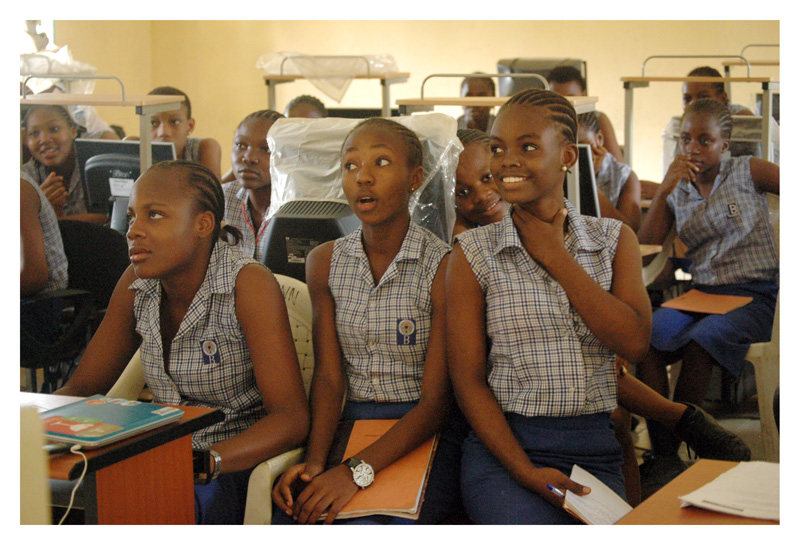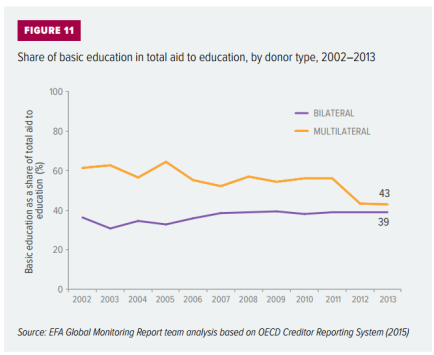The International Commission on Financing Global Education Opportunity released their Report this weekend. It sounds the warning bell on the need for greater financing for education. Released just weeks after our latest GEM Report, it should help get donors and governments sit up and pay attention to the urgency of breaking with past trends if we’re to achieve our education ambitions.
Just over a year ago, the Outcome document from the Oslo Summit on education laid out the mandate for the Commission Report: “Its purpose will be to explore and invigorate the case for investment in education and bring about a reversal of the current underfunding. It will seek to identify means of deploying the resources available in more effective, accountable and coordinated ways.”
One of the highlighted figures of the Commission Report is that the total cost of achieving this vision is three trillion dollars. This is roughly ten times the amount the GEM Report calculated last year as the annual total cost for education targets. But the vast difference is misleading. The additional cost is accounted for by the fact that the Commission includes upper middle income countries, which have far higher cost levels per capita. The Commission also includes the cost of post-secondary education, which makes up a third of spending in low income countries and almost half of spending in low and middle income countries put together.
The Commission Report argues that “simply advocating for increased resources based on a financing gap analysis has not been and will not be effective”. However, it then proceeds to calculate the gap. In total, the annual average external finance gap for low income countries is $44 billion a year over the period 2015-2030 of which it is recommended that $25 billion be covered by aid. Excluding the amount of aid already disbursed, this is almost identical to the $21 billion a year calculated by the GEM Report for low income countries. In other words, the Commission also echoes the GEM Report’s call for a more than six-fold increase in aid to education to low income countries.
Of course estimating the gap was not the main objective of the Commission. Instead, the Report focuses on how this gap could be reduced through gains in efficiency and investments in more effective policies. It responds to its mandate, which calls for it to help “bring about a reversal of the current underfunding”.
In that respect, one of its core recommendations outlined is for a new Multilateral Development Bank (MDB) mechanism, which would catalyze investment for education.
This mechanism, the Commission Report says, would allow for MDBs to work together as a coherent system, establishing a platforms that would help incentivize funding from MDBs themselves, but also from other sources. This is certainly a valid ambition. The Commission Report reminds us that the share of education among multilateral donors fell from 10% to 7% in the last decade. Leaving aside the question posed in our GEM Report as to whether multilateral channels are more efficient than bilateral channels, a major question is what such platforms can do to reverse this trend.
Certainly, it has become more common for donors to earmark the funds they provide to multilateral agencies through trust funds specific to sectors or issues. A survey of OECD DAC members attributed this trend to donors’ desire for visibility and influence. And it is also true that earmarking has been used extensively to increase funding to the health sector. However more multilateral earmarking can create challenges if it increases fragmentation within multilateral organizations.
It is possible that the new mechanism would manage to address this potential fragmentation, and bring clarity to the process. A question does arise, however, as to who exactly this mechanism is, where it sits, and what it looks like. Greater transparency would be needed in its governance, especially if it were to have says over which education plans were funded, and which not.
In addition, the Commission Report says it would pay particular attention to countries transitioning to middle income status, which receive both grants and loans. This is meant to emphasize that the mechanism would work alongside, and not instead of, GPE, which focuses primarily, though not exclusively, on low income countries. However, if the Commission Report seeks to make a decisive shift in financing education, it should make sure this is going to happen for low income countries first, and not as an afterthought. Likewise, if we do manage to convince MDBs to increase the percentage they allocate to education from 7% to 15%, as the Commission Report hopes will happen, there is no clear indication of how those funds would be channeled in a way that would benefit marginalized populations whose children might still never set foot in a classroom.
The advocacy around the Commission Report will continue for the next year to see how its recommendations on financing can be implemented in practice. This process will iron out some of the details, and answer questions that need to be raised around some of its assumptions. However, there is no doubt the Commission Report takes an important stab at creating a “proposal for the largest expansion of education opportunity in modern history”. And this is no exaggeration. Our latest GEM Report shows that, even at the fastest rate of progress ever seen, no country in sub-Saharan Africa and Southern Asia would reach our new global targets of universal secondary completion by 2030. Whatever we do, we must do it differently. Our old ways of working are not primed to get the job done.



